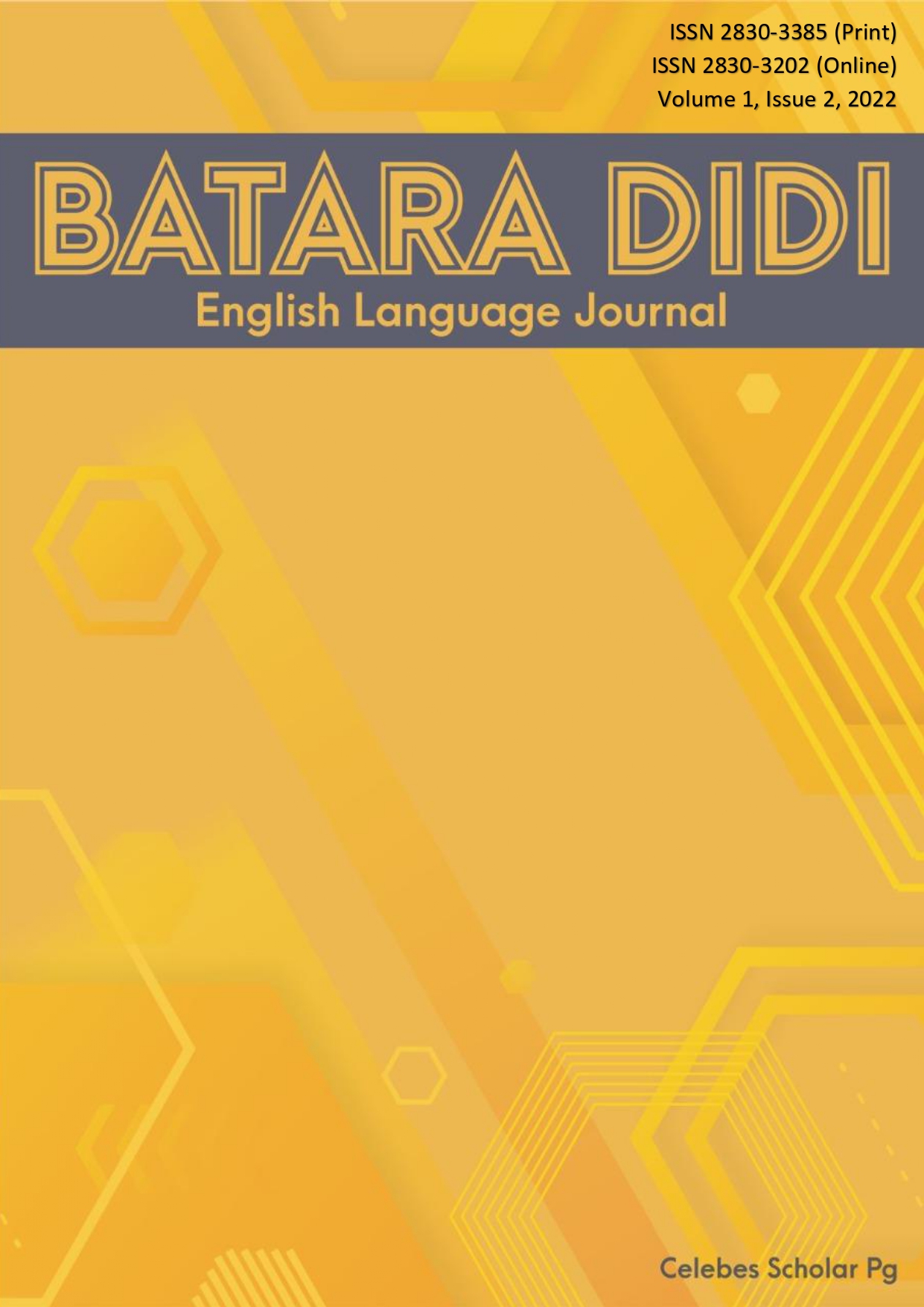The The Effectiveness of REALIA as a Medium for Writing Descriptive Text
DOI:
https://doi.org/10.56209/badi.v2i1.54Keywords:
Writing, Realia, Descriptive TextAbstract
The goal of this study was to see how effective Realia was at writing descriptive text by the first semester of English at Unismuh Makassar. The sample for this study was drawn from two classes using the purposive sampling technique, with one group serving as the experimental class and the other as the control class, for a total sample of 30 students from the English Department at Unismuh Makassar's first semester. This study's instrument was a writing test. The researcher used a pre-test and a post-test to collect data. The researcher taught the descriptive text using realia. The researcher used the t-test to statistically analyze the data. The t - value was calculated to be 6.55. The t- table value was 2.00 based on the 0.05 significance level, and the computation revealed that the t- value was more significant than the t- table, which was 6.55>2.00. The effectiveness of realia can also be seen in the experimental and control groups' post-treatment scores. The experimental class's mean posttest score was 86.51, putting it in the very good category. The control group's mean posttest score was 76.54, putting it in the good category. The experimental group outperformed the control group, it is possible to conclude. Based on the t-test results, it can be demonstrated that using realia as a media in writing, specifically descriptive text for students, is a reference for teachers.References
Ahmadi, N., & Besançon, M. (2017). Creativity as a stepping stone towards developing other competencies in classrooms. Education Research International, 2017. https://doi.org/10.1155/2017/1357456
Baldassano, C., Hasson, U., & Norman, K. A. (2018). Representation of real-world event schemas during narrative perception. Journal of Neuroscience, 38(45), 9689-9699. https://doi.org/10.1523/JNEUROSCI.0251-18.2018
El Sulukiyyah, A. A., & Aisyah, R. N. (2019). Teaching Essay Writing Using Authentic Materials to Improve Students' Writing Performance. JEES (Journal of English Educators Society), 4(2), 79-87. https://doi.org/10.21070/jees.v4i2.2443
Hana, W. U. Z. (2020). Teaching Writing by Using Realia and Total Pshycal Response to the Eight Grade Students of SMPN 4 Ponorogo (Doctoral dissertation, IAIN Ponorogo).
Ho, D. T. K., & Intai, R. (2017). Effectiveness of audio-visual aids in teaching lower secondary science in a rural secondary school. Asia Pacific Journal of Educators and Education, 32, 91-106. https://doi.org/10.21315/apjee2017.32.7
Javadi-Safa, A. (2018). A brief overview of key issues in second language writing teaching and research. International Journal of Education and Literacy Studies, 6(2), 12-25. https://doi.org/10.7575/aiac.ijels.v.6n.2p.15
Kukulska‐Hulme, A., Lee, H., & Norris, L. (2017). Mobile learning revolution: Implications for language pedagogy. The handbook of technology and second language teaching and learning, 217-233. https://doi.org/10.1002/9781118914069.ch15
Li, X., & Liu, Q. (2020). Social media use, eHealth literacy, disease knowledge, and preventive behaviors in the COVID-19 pandemic: Cross-sectional study on Chinese netizens. Journal of medical Internet research, 22(10), e19684. 10.2196/19684
Matamoros-González, J. A., Rojas, M. A., Romero, J. P., Vera-Quiñonez, S., & Soto, S. T. (2017). English language teaching approaches: A comparison of the grammar-translation, audiolingual, communicative, and natural approaches. Theory and Practice in Language Studies, 7(11), 965-973. http://dx.doi.org/10.17507/tpls.0711.04
Nittrouer, S., & Caldwell-Tarr, A. (2016). Language and literacy skills in children with cochlear implants: Past and present findings. Pediatric cochlear implantation: Learning and the brain, 177-197. 10.1007/978-1-4939-2788-3_11
Pratama, A. H., & Dewi, N. S. N. (2022). Demotivated Students during Online English Learning in Covid-19 Pandemic: Voices from Indonesian Students. JELITA: Journal of Education, Language Innovation, and Applied Linguistics, 1(2), 79-93. https://doi.org/10.37058/jelita.v1i2.4761
Venter, E. (2017). Bridging the communication gap between Generation Y and the Baby Boomer generation. International journal of Adolescence and Youth, 22(4), 497-507. https://doi.org/10.1080/02673843.2016.1267022
Zulaikah, Z., Agustina, E., & Muklas, M. (2018). An Analysis Student’s Ability in Writing Descriptive Text of Second Semester of English Educational Program at STKIP Nurul Huda Oku Timur. Jurnal Darussalam: Jurnal Pendidikan, Komunikasi Dan Pemikiran Hukum Islam, 10(1), 12-30. https://doi.org/10.30739/darussalam.v10i1.264
Downloads
Published
Issue
Section
License
Copyright (c) 2023 BATARA DIDI : English Language Journal

This work is licensed under a Creative Commons Attribution-ShareAlike 4.0 International License.
Articles of the BATARA DIDI : English Language Journal are licensed under
https://creativecommons.org/licenses/by/4.0.






